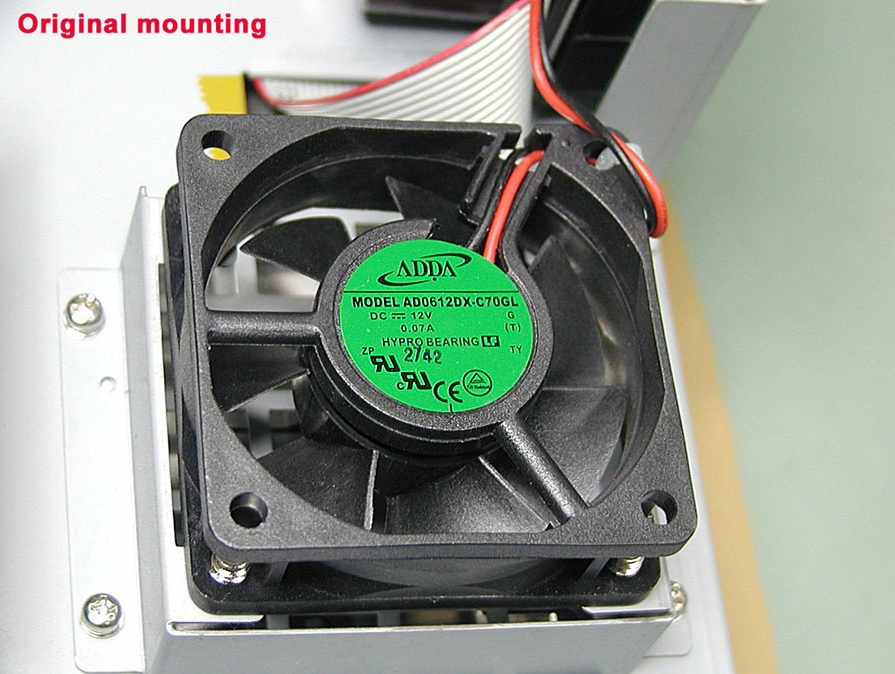
Electrical test and measurement equipment Blog
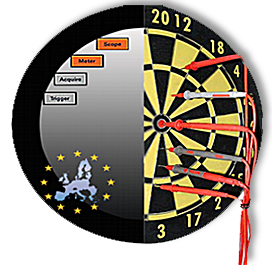
ITTSB Europe


What’s on your mind Kiriakos ?

Mini articles
2013
Few ideas for improvements if you feel that you need any.
Bench test equipment, some times become an unpleasant fan noise source.
Bench test equipment, some times become an unpleasant fan noise source.
Sometimes the little motor fan which usually keeps cool the power supply or other parts of our new oscilloscope or function generator or other bench test equipment, it does become one audible problem.
No I am not talking about a damaged motor fan which is normal to become a source of noise when it comes close to 60% of it life cycle, also poor lubrication and worn out parts is not always the problem regarding annoying noise.
For about 10 years I did pass from the large school of computer modifications, CPU over clock and memory timing tweaking plus improved air cooling with low noise are the main topics of this mini unofficial technical university, and no I am not exaggerating by using this set of words.
If you do it seriously and get in the path to design a prototype fan duct or a system of fans which is capable to deliver better targeted cooling than what a simple motor fan can do, eventually you will discover many secrets regarding motor fan design.
Fan noise can be caused by three main reasons.
a) Electrical noise
A poorly designed fan which is using half in size motor coil than what it is needed it does become a source of clicking sounds.
b) Poor blades design can make the fan to spin faster but with out delivering the expected air flow.
c) The motor shaft as moving part in cooperation with sleeve or ball bearings.
Even in the small size DC fans the ball bearings are the most reliable solution but they do produce more mechanical noise.
Hydro bearing is a new relatively technology, which it does offer improvements even regarding mechanical noise elimination.
d) Wrong type of mounting over a surface / Vibrations.
Usually four screws are what are needed so to mount the fan where it needs to.
But there are even far advanced methods to eliminate any vibrations and this has a value to huge electrical motors which are mounted in to a metallic frame or base of cement, but also to the tiny DC motors.
Those technical solutions are known only to the few who have explored the idea of silent PC cooling.
Small rubber type mounting parts works as shock absorbers and they isolate any mechanical fan noise from spreading vibrations at the mounting point.
Those test & measurement equipment manufacturers they focus all their power for making a first class product, but not many are paying attention to such small details.
I wrote this article as assistance to some people which found the fan noise of their new instrument as source of annoyance.
The suggested improvement is solely the use of rubber type mounting parts as pictured in the pictures below.
This is a by far better choice to drop down few db of the motor fan noise, than replacing the motor fan with another more silent but with poor air flow.
Its product designer has conducted testing so the power of the motor fan to offer sufficient cooling results.
Also the sufficient cooling plays a significant role over the life cycle of the modern electrolytic capacitors which coexist in every step-down pulsing DC power supply.
If your equipment arrived from a manufacturer which is not famous at using top ranked parts like hydro bearing fans, your best bet is to replace the fan with an equivalent in air pressure hydro bearing one.
And use my suggestion about the rubber mounting parts as the final improvement.
The final results with this combination of motor fan and mounting type is truly remarkable.
And with me they will agree most people which are aware of those solutions, and they love silent computing or need a silent PC system for audio recordings studio, or they need a minimal fan noise in their ears.
This article is for people whom they know what they are doing, and so there is no need to mention that by engaging with the inner world of your device there is always a chance to void the warranty plan.
In my GW Instek oscilloscope I did not have a problem to remove the rear cover and make this improvement regarding warranty seal.
Not to say that I did informed the company in Taiwan and their engineers shown significant interest about to test and use this simple solution in the future.
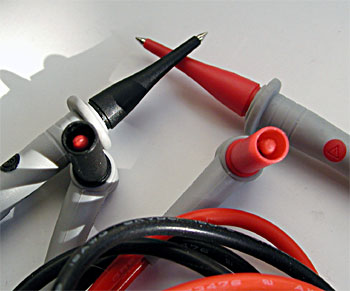
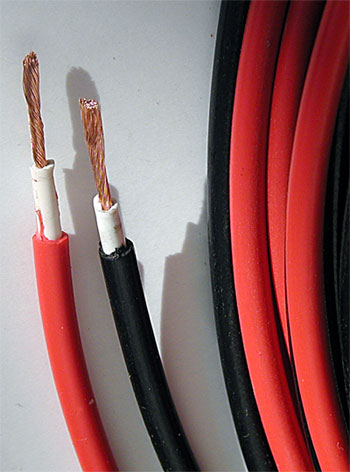
Generally speaking the new safety standard it is changing many things, some are related to our personal habits as users, and some others affect us as consumers.
For the first part I have an complain or rant regarding the fact that the very short exposed tips of the new test leads, they do not work out regarding measurements in the European Schuko plug.
And in this point I have to ask: Did any electrician engineer of Europe really checked or investigate this detail before he signs up in favor of this harmonization?
The electrician performs several measurements, while direct measurements on distribution panels and naked contact areas of cables are easy to do, the voltage measurement in any short of assembled Mains plug is now more difficult to be performed with those test leads, except if you are lucky to have three hands.
This time I like to share some info and personal thoughts regarding the changes which the new revisions of the IEC 61010 bring in our life.
IEC 61010 safety standard and multimeter's (2012 - 2014)
While I would expect as electrician and consumer all the info regarding safety standards to be accessible for free and by anyone interested, they are not.
The related document is on sale for a price close to 200 EUR.
Eventually the IEC 61010 safety standard is now in their third edition.
Europe has harmonize to it all ready, and the Americans did it too this May 2012 and here is the announcement regarding the UL 61010 third edition.
As of May 11, 2012, the United States Technical Advisory Group and harmonization committee published the new North American harmonized standards.
While this Safety standard consists of a pile of information’s for several matters, the IEC 61010 second edition contains the most updates which affects all ready the market of measuring instruments and their accessories (test leads), but lets read just the title of this document below, in order to become more enlighten.
Safety requirements for electrical equipment for measurement, control, and laboratory use 61010 Part-2-033, set particular requirements for hand-held multimeter and other meters, for domestic and professional use, capable of measuring mains voltage (120 - 220V).
How all those translate in a simple language?
Well mainly those are the new guide lines which the manufacturers should follow in order their products to comply with the latest safety standards, which will aloud them to carry the certification logo which is the approval of compliance, and in a way is like a passport so their products to enter into a specific national market as safe.
The American consumer will have this reinsurance by seen a product stamped as UL 61010 and alike the European will feel the same when a product is stamped as IEC 61010.
For the eager ones so to learn more, I will say that the latest IEC 61010 includes information which targets in three directions.
1) Measuring instruments construction regarding PCB clearances, creepage's.
(The leakage path along the surface from one end to the other, called as creepage)
Electrical solid and thin film insulation and molded and potted parts, Temperature requirements, also requirements for foreseeable misuse and ergonomics plus risk assessment, pollution degree, conformal coatings.
But the most significant change is the fact that the scope now covers both professional and non-professional products.
2) Regarding test leads and accessories, the most obvious changes in the test leads which arrive in the newly packaged DMM, are the ones with an minimum exposed tip, at the length of 4 mm when the center pin (contact area) it is still in the diameter of 2mm.
The first conclusion could be that the fully exposed tips at the length of 18 mm they got banned in a way from the packaging of recent made multimeter's.
Another difference or new change is the fact that the banana plugs which connect on the multimeter they are coming now with a plastic protective red hat over the center pin, which works as finger guard.
One third change which I am not aware if it relates with the IEC 61010, is about the cables of those test leads.
In the beginning of 2012 (one year back) I was in need to make a test leads extension, and the cables that I personally purchased from a large store in the hart of Athens (Greece) are having dual sleeves.
The first one inner sleeve is white, and the external has the color of preference as read or black, this new change comes to assist regarding the easy detection of cable wear (damage).
I am unable or better said unwilling to verify that those cables which came with the multimeter's (evaluation samples) at the ITTSB are also following this design, as I am in total denial about to chop them out, just to cover my curiosity.
3) The third direction is about education courses probably for the product design engineers, so become more familiar of the How to, about to correctly implement the new guide lines.
And also as it is stated in the IEC 61010-2-30, the user manual or user guide of an product capable to measure Mains voltage, it should have an specific section explaining how to determine the working voltage of a mains circuit.
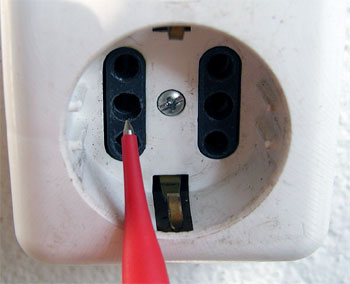
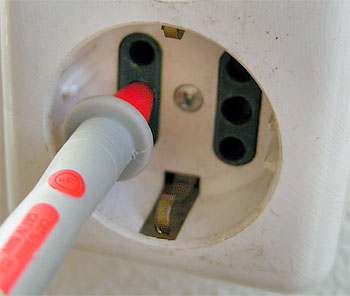
Those pictures are here to illustrate that when the test lead gets all the way in, it is touching thin air, and the electrician is forced to keeps the leads is a hard to obtain angle so to make an good connection, which is hard even by holding one test lead in place, to set both in position becomes a true challenge.
Another practical problem is that many meters come ready for data logging, did any one wondered how I would keep the test leads in place in a European Schuko plug?
Only BRYMEN from Taiwan looks to have made some thought regarding this detail, and they offer CAT IV 1000 test leads with fully convertible front ends, as minimum exposed and also covered tips by the use of plastic covers, and even banana ends which are getting over the test lead tip, and makes them a very preferable option for measurements over wall plugs, but you have to watch out to not loose all those tiny bits.
By the way should I speculate that among with the 18 x 2 mm test leads which gets banned in a way, are also banned and the 18 x 4 mm banana ones?
I think that the German Metrawatt was offering in the past exposed banana type leads as standard test leads in their meters. (they have lots Schuko plugs too)
Regarding the commercial part as consumers, the new strict IEC 61010 caused all ready some pressure to the European countries, and I did spotted Spain for example, which started characterizing as unsafe some low cost Asian meters which become recently imported in their country.
And they did that due the exposed metallic parts on the test leads, with out to take under consideration the unsafe design of the meters as primary subject which it is one.
My last over all thought is that other than regulations we need and new product solutions as accessories which should be offered from the manufacturers of those meters, for free.
And I do have some fresh ideas as suggestions, for example Agilent it does offer modular test leads with exchangeable the final test bit, it would cost them nothing to add in their standard test leads package one European Schuko plug adapter with inputs at the back for shrouded bananas.
A simple cheap accessory which it would add more practical value in anything shipped to Europe by them.
My above suggestion is also directed to Megger UK, which offers the same test leads design as the Agilent do.
Personally I do favor this design of test leads for many years, is not a fresh marketed one, but it is exceptionally smart and practical as modular design which was introduced by CHI - SHING in China, before it change their corporate profile in to a exclusively OEM.
Small corrections like those they can assist the life of the end user electrician, no matter of his specialization of type of field work.
The IEC is not going to step back, and our only hope is the given feedback to manufacturers, and the hope that they will use it so to make more wise choices regarding those test leads.
By the opportunity of this small article I wish a happy 2013 to all my readers.
Kiriakos Triantafillou – Greece
Asia is now leading the dance regarding R&D and fresh products and this info is not fresh news.
Next generation scope meters are around the corner.
Intro:
My motives about writing this mini article are mainly of the view point of consumer.
Pricing and features, whish list and expectations, East and West markets reaction, and also what called as a modern scope meter? Are questions which they do require answers.
Scope meters (handheld oscilloscopes) are one of the main topics which ITTSB have selected since the first day of it operation.
My wish was to be able to touch them and compare them, so to be able to share the information and offer a useful pack of advices to my readers.
The market of scope meters today looks very confusing, mostly due the pricing in the west world.
Technical specifications and the features of those products are available but not all technical specifications are well documented in comparison with the desktop oscilloscopes.
In my attempt to investigate in depth of what is going on? So to make my own conclusions, I did discovered that in this specific products category the marketing in the west world is very silent, in comparison with what it happening regarding the evolution or technological progress of desktop solutions.
What I also discovered as problem in my personal research was the lack of definition of what is called as a next generation of DSO scopes.
Generally speaking some recorded milestones as for example the use of windows operating system in oscilloscopes, or the USB connection with computers, or even a color VGA screen, it was been used as marketing points or definition, so the newest product to be marketed as NEXT generation of DSO.
What makes the portable DSO (scope meter) so special?
a) Portability and isolated inputs which aloud us to perform measurements directly to mains.
b) Enhanced software which automates measurements and settings which the human hand usually does in the desktop ones.
c) It is supposedly more easy to use, at measurements which are common to electrical troubleshooting.
d) You can finally have a visual representation of distorted sine waves which are caused by imperfect or malfunctioning inverters.
The future is here, and what we are going to see happening in the market is truly breath taking.
We have all ready take a taste of what the latest R&D had offered in the medium priced desktop Oscilloscopes of 2013.
RIGOL and GW Instek are currently leading the market with fresh technology, which focuses mainly in fast Oscilloscopes regarding computing power, and the most important than all factors is the significant strong engines in the graphic representation of waveforms.
The new word in the mouth of consumers is the waveforms per second that a scope can compute and display.
The introduction of scopes with high waveforms per second it is also related with higher VGA resolution, so to be enough space for the proper presentation of detail which jumps out from those powerful ASIC (application specific integrated circuit) components.
One more simplified description of what is happening could be for example the single core CPU in comparison with one quad core CPU and it benefits.
In the benefits we have see more powerful home or business class computers which they need significantly less energy and at the same time they do offer amazing computing power.
How the west market responds in the distribution of scope meters?
All that I can see is offerings of technology that is now old, two to three years old R&D at list.
And the worst of all, it is over priced higher than the wildest imagination.
The realization that even the R&D which most western manufactures are using is Chinese and Korean it gave me the message of what is happening today.
The American and European industrialization is out of the game as source of inspiration for products tailored in western needs.
China is the new kingdom of tremendous industrial activity.
China is the producer and the largest customer of the latest technology even in electronic test and measurement products.
And so it does not need much of imagination the conclusion that if you need the latest and greatest tools for a job, you are forced to search for solutions in the new source by leaving behind any cultural prejudice regarding western pride and flag.
Which brand names in Asia own advanced R&D for making scope meters?
In this question the answer is not easy, due the fact that some Asian companies are offering (sale) their R&D occasionally, and this it does not offer them the title of the scope meter dedicated manufacturer.
In the list of the more significant names is:
a) Jiangsu Lvyang Electronic Instrument Group Co., Ltd (China)
b) WENS precision co.ltd. (Korea)
The new addition as competitor of those two is Shenzhen Micsig Instruments Co., Ltd
They are holding in their hands far advanced R&D equal or better than what companies as RIGOL & GW Instek presented in the 2013 market as desktop scopes, and also this advanced technology is all ready implemented in the scope meters of Micsig since 2012.
In 2012 Micsig received all the necessary certifications and approvals so to expand in international trading.
What I am currently not aware is the pricing of Micsig products.
What is the current pricing of scope meters is China?
This answer is easy if you have spent one year of your life by monitoring the pricing and the offerings of major Chinese distributors.
The pricing are formed by the value or class of R&D of its one manufacturer.
Some are known of making educational instruments with low to average specifications.
And some others are fighting in the first line so to present high quality products which will gain interest in industrial and military needs.
The latest are the crop of the cream regarding performance.
The only true comparison point which I have proofs is the fact that now days what is considered in the western market as top solution of 5.000 Euro it does not cost more in Asia than 1500 American dollars as retail price.
And the low cost scope meters which are the slowest and is actually 10 years old R&D are priced to 500 American dollars or much less.
Why the newest scope meters are that necessary?
This answer it can be offered in 20 pages of text but I will keep it simple.
What I do see in the older scope meters which are currently available as top solutions in the west market is good bandwidth and sampling rate.
The 200MHz 2GS/s scope has enough computing power for basic measurements with acceptably accuracy, but they do fall sort in many other aspects.
The waveform which looks as cucumber in a 320×200 screen, the screen update is slow starting for 4 times per second and hardly goes more than 15.
They are slow and unable to capture and display properly a fast glitch that is events that is occurring randomly and the scope is unable to detect and present on screen.
Battery life is not that great either, and due their poor general performance as scope meters they are not a favorite choice even as portable solution for advanced electronic repairs.
By owning today one of the true new generation of oscilloscopes of 2013 that is the GW Instek GDS-2102A, I did feel immediately the benefits of the 800x600 display and the high rate of waveforms per seconds, with thin crisp lines and speed which is capable to show even the smallest detail in the range of 50Hz up to 20MHz.
The internal memory of 2M Points is another strong point regarding recording and reviewing waveforms.
Additions like the logic analyzer made it a remarkable all-rounder as product which at the same time it is wisely priced.
It does not really mater if you will take advantage of all the options so to feel happy about the product, and yes I am talking here about customer’s satisfaction.
Micsig started to offer the ideal all-rounder in portable scopes, just a visit in their home page will be very informative regarding the specifications of their dream machines, amazingly high waveform update rate and bandwidth and memory and high sampling and logic analyzer and even touch screen.
On paper it looks truly ideal to me, and I am getting ever more excited by the idea to have an equal in every aspect scope meter compared to my desktop.
Naturally I am not a kid anymore and just promises are not accepted as facts,
Micsig promised one sample of their latest flagship which will be out at about August - September of 2013, so to be reviewed by ITTSB and stay in my collection of samples.
The title of this mini article is truly sincere, new scope meters with amazing specifications are in the next corner but down in Asia.
How soon it will take to actually touch them it is a mater of time and willingness for trading cooperation’s which will include a truly honest pricing.
The concept of fair trade and pricing between Asia and the west world is currently ill.
There is too much greed which is chocking consumers and works even against the profitability of those who called as distributors.
By my opinion ODM products or OEM products, in both situations the marketing it should start walking with sincere pricing, there is not much time left, Chinese companies are all ready moving in Europe so to cut out any middle men.
Their mistake is that we can not trust them as consumers.
Therefore we will keep supporting national T&M distributors mostly because they have the power to defend the rights of the end consumer if something goes wrong.

Copyright Notice:
The content of this web site is copyright protected. You may download, display, print and reproduce this material in unaltered form only (retaining this notice) for your personal, non-commercial use or use within your organization. Apart from any use as permitted under Hellenic Copyright law, all other rights are reserved. Requests and inquiries concerning reproduction and rights should be addressed to: Kiriakos Triantafillou, 55 Gatsou, TK38333, Volos, Greece, E-mail: info@ittsb(dot)eu
You are not permitted to commercialize the information or material without seeking prior written approval from Kiriakos A. Triantafillou. You are not permitted to use the ITTSB.EU web site to sell a product or to increase traffic to your web site.
Kiriakos Triantafillou © 2012 - 2025
Name space registered to EURid May 8, 2012
